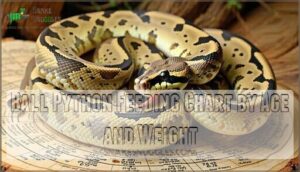This site is supported by our readers. We may earn a commission, at no cost to you, if you purchase through links.

Hatchlings under 100 grams need meals every 4-5 days, while juveniles up to 500 grams eat weekly to bi-weekly.
Sub-adults require feeding every 2-3 weeks, and adult snakes over 1,000 grams can go 3-6 weeks between meals.
Your snake’s age, weight, and species determine the exact timing, and it’s essential to consider consistency and proper prey sizing – think of it as meal planning for your reptilian roommate.
Getting the schedule wrong can lead to obesity or malnutrition, but there’s more to take into account than just timing.
Table Of Contents
- Key Takeaways
- Feeding Schedule Guidelines
- Choosing The Right Prey
- Feeding Techniques for Ball Pythons
- Common Feeding Troubles and Solutions
- Health and Nutritional Considerations
- Feeding Chart and Frequency
- Feeding Ball Pythons by Age
- Prey Size and Supplements
- Tips for Feeding Your Ball Python
- Monitoring and Adjusting The Feeding Schedule
- Frequently Asked Questions (FAQs)
- How often should you feed a snake?
- How do you feed a snake a healthy diet?
- Do snakes need a balanced feeding schedule?
- Why should you keep a feeding chart for your snake pet?
- How often should you feed a pregnant mother snake?
- How do you know if a snake is eating?
- How often should I feed my snake in a day?
- What is the feeding pattern for snakes?
- Should I feed my snake at night or during the day?
- How do you feed a snake?
- Conclusion
Key Takeaways
- Feed based on age, not appetite – Hatchlings need meals every 5-7 days, juveniles every 7-10 days, and adults every 14-21 days, regardless of how eager they seem for food.
- Match prey size to your snake’s thickest body section – Choose prey that’s about 10-15% of your snake’s total weight to prevent regurgitation and ensure proper digestion.
- Don’t handle for 72 hours after feeding – Your snake needs this time to digest properly, and handling too soon can cause dangerous regurgitation.
- Track everything in a feeding log – Record dates, prey sizes, and your snake’s responses to spot health issues early and adjust your schedule as they grow.
Feeding Schedule Guidelines
Proper feeding schedules guarantee your snake stays healthy and grows at the right pace throughout its life.
You’ll need to adjust meal frequency based on your snake’s age, with hatchlings requiring food every 5-7 days while adults can wait 2-3 weeks between feedings.
This will help ensure your snake receives the proper care it needs to thrive.
Age-Appropriate Feeding Schedule
Creating an effective age-appropriate feeding schedule guarantees healthy snake growth and prevents dietary issues.
Your ball python’s nutritional needs evolve substantially as they mature, requiring strategic feeding cycles that match their developmental stages.
- Hatchlings (0-6 months): Feed every 5-7 days with pinky or fuzzy mice to support rapid initial growth
- Juveniles (6 months-1 year): Switch to 7-10 day feeding frequency using small mice or rat pups
- Adults (3+ years): Maintain healthy weight with 14-21 day intervals using appropriately-sized rats
Frequency of Feedings Based on Age
Your ball python’s growth rates dictate feeding frequency.
Hatchlings need meals every 5-10 days due to rapid snake development, while juveniles require weekly feedings.
Adults eat every 10-14 days as their nutrient needs change.
This snake feeding schedule guarantees proper growth without overfeeding risks.
| Age Stage | Feeding Frequency |
|---|---|
| Hatchlings (0-6 months) | Every 5-10 days |
| Juveniles (6-12 months) | Every 7-10 days |
| Sub-adults (1-3 years) | Every 10-14 days |
| Adults (3+ years) | Every 14-21 days |
| Breeding adults | Every 2-3 weeks |
Factors Influencing Feeding Frequency
Understanding your snake’s feeding frequency requires monitoring several environmental and biological factors that directly impact their appetite and metabolism.
- Temperature Effects: Cooler temperatures slow your snake’s metabolic rates, reducing feeding frequency needs during winter months.
- Humidity Impact: Proper humidity levels support healthy shedding cycles, while poor conditions can suppress appetite between feeding cycles.
- Snake Size: Larger adults require less frequent meals due to slower metabolism, while juveniles need consistent nutritional balance for growth.
Adjusting Feeding Schedule for Growth
Like a gardener adjusting care for growing plants, you’ll need to modify your snake feeding schedule as your ball python develops through different growth stages.
Snake development requires careful size adjustments to match nutrient needs throughout feeding cycles.
Growth Stage Prey Size
Monitor your snake feeding chart and watch for these growth milestones!
Choosing The Right Prey
Selecting the right prey for your ball python isn’t just about grabbing any rodent from the pet store.
You’ll need to match prey size to your snake’s age and weight while considering nutritional variety to keep your python healthy and thriving.
Prey Size and Type for Ball Pythons
When selecting prey for your ball python feeding routine, proper prey size guarantees safe digestion and prevents health complications.
Here’s your essential prey selection guide:
- Size matters most – Choose prey as wide as your snake’s thickest section
- Weight ratios work – Target prey around 10% of your python’s body weight
- Rats over mice – Adult ball pythons thrive on appropriately-sized rats
- Frozen-thawed preferred – Safer than live prey, easier storage and handling
- Age-appropriate sizing – Hatchlings need mouse pinkies, adults need adult rats
Your ball python diet depends on accurate prey selection using feeding charts that match snake feeding schedule requirements for ideal snake nutrition.
Understanding ball python care is vital for creating a suitable environment and feeding plan for your pet.
Ideal Prey Types for Ball Pythons
The right prey types form the foundation of your ball python’s health and feeding habits.
Your snake thrives on quality nutrition from these preferred options:
- Rats: Offer superior protein content and balanced nutrition for ideal snake nutrition
- Mice: Provide excellent starter prey for younger pythons switching in prey size
- African Soft-Furred Rats: Deliver premium ball python diet benefits with ideal protein-to-fat ratios
Quality prey from reputable suppliers supports your ball python feeding routine to promote long-term health.
Proper prey size guidelines are essential for a ball python’s overall well-being.
Variety in Prey Types for a Well-Rounded Diet
Diversifying your ball python’s carnivorous diet creates best snake nutrition through strategic feeding rotation.
This prey diversity guarantees nutrient balance while preventing dietary monotony that can lead to feeding strikes.
| Prey Type | Feeding Frequency | Primary Nutritional Benefits |
|---|---|---|
| Mice | Primary staple | Complete protein profile, ideal fat content |
| Rats | Weekly rotation | Higher protein density, larger prey option |
| Quail | Bi-weekly | Rich amino acids, natural feather stimulation |
| Guinea pigs | Monthly treat | Enhanced calcium, varied texture experience |
| Chicks | Occasional | Vitamin A, natural bone content |
Your snake feeding chart should incorporate this dietary variety systematically.
Rotating between different prey types mimics wild hunting patterns while delivering essential nutrients that single-prey diets can’t provide.
This feeding schedule approach prevents nutritional deficiencies and maintains your python’s interest in meals, reducing the likelihood of feeding refusal that’s common with monotonous diets.
Prey Size Chart for Ball Pythons
Choosing the right prey size for your ball python isn’t guesswork—it’s about matching prey sizing to your snake’s body diameter for ideal snake nutrition. Your ball python feeding chart should reflect their growth stages to prevent digestive issues.
Here’s what makes prey selection straightforward:
- Python diet shifts from mice to rats as snakes mature
- Snake feeding frequency decreases as prey size increases
- Proper feeding charts prevent overfeeding complications
- Weight monitoring guarantees accurate ball python prey sizing
- Consistent snake feeding schedule supports healthy development
- Hatchlings (45-80g): Hopper mice (7-12g)
- 3 months (120-220g): Fuzzy rats or small mice (13-19g)
- 6 months (270-360g): Rat pups or adult mice (20-30g)
- 1 year (500-900g): Small rats or 1-3 adult mice (45-80g)
- 3+ years (900-2000g+): Medium rats or 4-5 adult mice (90-150g)
Remember: prey size should match your snake’s thickest body section for safe digestion.
Feeding Techniques for Ball Pythons
You’ll master three essential feeding techniques that guarantee your ball python thrives and grows properly.
These methods address common challenges like picky eaters and help you establish a consistent feeding routine that works for both you and your snake, using techniques that ensure your snake’s overall health and well-being.
Live Prey Feeding Vs Frozen/Thawed Prey Feeding
You’ll often face the choice between live feeding and frozen thawed prey for your ball python.
Prey Safety strongly favors frozen options—live rodents can injure snakes through bites and scratches, while frozen eliminates these risks entirely.
Snake Nutrition remains excellent with both methods, though frozen prey reduces parasite exposure.
Feeding Ethics considerations favor frozen thawed prey, preventing unnecessary suffering.
Most snake feeding schedules work better with frozen prey type options due to convenience and storage benefits.
When deciding on a feeding method, considering frozen food options can help you make an informed decision for your snake’s health and well-being.
Assisted Feeding Techniques for Ball Pythons
When your ball python refuses to eat, assisted feeding techniques become invaluable feeding tools. You can enhance snake nutrition by dipping pre-killed prey in warm chicken broth to stimulate appetite.
Python care experts recommend using feeding aids like forceps to dangle prey during nighttime hours when these nocturnal hunters feel most comfortable. These snake feeding techniques support digestive health without forcing consumption.
- Warm chicken broth creates enticing scents that trigger feeding responses
- Forceps provide safe distance while mimicking natural prey movement patterns
- Nighttime feeding sessions align with your python’s natural hunting instincts
- Pre-killed prey eliminates injury risks while maintaining nutritional value
- Gentle movement techniques help nervous snakes overcome feeding hesitation
Feeding Tips for First-Time Snake Owners
Getting started with ball python feeding doesn’t need to stress you out. Follow these essential snake feeding tips to master proper Pet Care and avoid common Feeding Errors.
- Use frozen-thawed prey to prevent injuries and improve safety
- Select prey matching your snake’s midsection width for proper Snake Nutrition
- Feed in a separate container to reduce cage aggression and improve Snake Behavior
- Wait 72 hours before handling to support healthy digestion
Common Feeding Troubles and Solutions
Even experienced snake owners face feeding challenges that can seem puzzling at first.
Understanding these common issues and their solutions will help you maintain your snake’s health and establish a successful feeding routine, which is crucial for a successful feeding routine to work.
Refusal to Eat and How to Stimulate Appetite
When ball pythons turn away from meals, don’t panic—feeding strikes happen frequently.
Refusal reasons include stress from environmental changes (affecting 30-40% of ball pythons), improper temperatures below 75°F, shedding cycles, or illness.
| Appetite Stimulation Method | Success Rate | Best For |
|---|---|---|
| Warmed, freshly thawed prey | 40% increase | Cold prey refusers |
| Movement simulation with tongs | 60-80% | Reluctant feeders |
| Scenting with chick down | Variable | Food aversion cases |
Monitor hunger cues like increased tongue flicking.
Your snake feeding schedule shouldn’t force meals—patience prevents eating disorders and reduces stress-related refusal to eat episodes.
Regurgitation and How to Prevent It
Regurgitation happens when your ball python brings up recently consumed food, creating digestive issues that affect their feeding schedule. Regurgitation Causes include improper temperatures, handling too soon after meals, or Feeding Stress from environmental changes.
Snake Digestion requires stable conditions to function properly:
- Maintain consistent temperatures between 78-88°F
- Wait 72 hours before handling after feeding
- Provide quiet, secure hiding spots
- Monitor for Regurgitation Signs like undigested prey
- Check for illness if Food Refusal accompanies regurgitation
Your snake nutrition guide should emphasize patience—rushing the process disrupts natural digestive patterns and proper feeding frequency.
Overfeeding and How to Avoid It
Overfeeding poses serious obesity risks that threaten your ball python’s health.
Watch for visible fat rolls between scales and a rounded body shape – clear signs you’ve exceeded feeding limits. Stick to your snake feeding schedule and resist the urge to offer extra meals.
Healthy appetite doesn’t mean constant feeding. Follow proven feeding frequency guidelines in your snake nutrition guide to prevent digestive issues.
Remember: obesity prevention starts with disciplined snake nutrition practices that prioritize your python’s long-term wellness over short-term satisfaction.
Health and Nutritional Considerations
Maintaining your ball python’s health requires careful attention to nutritional balance and body condition monitoring.
You’ll need to recognize malnutrition signs, provide essential supplements, and track weight changes to guarantee feeding success and achieve the best possible results, ensuring complete concepts are considered for optimal health.
Signs of Malnutrition in Ball Pythons
Recognizing malnutrition symptoms early helps you maintain your ball python’s health and prevent serious complications.
Early detection of feeding problems can save your ball python’s life and prevent costly vet visits.
Watch for these warning signs that indicate feeding issues or nutrient deficiency:
- Weight loss with visible muscle wasting around the spine
- Lethargy and reduced movement during active periods
- Incomplete shedding with retained skin patches
- Sunken eyes and thick, sticky saliva
These malnutrition symptoms signal your snake’s nutritional balance needs immediate attention through proper snake feeding schedule adjustments.
Supplementing The Diet With Vitamins and Minerals
Ball pythons eating commercial rodents may lack essential nutrients found in wild diets, making supplementation vital for preventing deficiencies.
You’ll want to dust prey lightly with calcium plus D3 supplements, especially for growing snakes or breeding females.
| Supplement Type | Recommended Products |
|---|---|
| Calcium with D3 | Repashy Calcium Plus LoD |
| All-in-One Formula | Arcadia RevitaliseD3 |
| Indoor Snakes | Miner-All Indoor Formula |
| Frequency | Every 4th feeding (light dusting) |
| Storage | Cool, dry place; replace every 6 months |
Monitoring Weight and Body Condition
While supplements help maintain nutritional balance, tracking your ball python’s physical changes tells the real story of their health.
Regular weight tracking and body scoring give you concrete data to work with.
Monitor these key indicators for ideal health:
- Weight gain patterns that match expected growth rates
- Body condition showing smooth curves without visible spine
- Feeding log entries that correlate with consistent weight increases
- Health checks revealing proper muscle tone and fat distribution
You’ll want to weigh your snake monthly and document everything in your feeding log.
Feeding Chart and Frequency
Creating a thorough feeding chart helps you establish the right schedule for your ball python’s nutritional needs at every life stage.
You’ll need to adjust both feeding frequency and prey size as your snake grows from hatchling to adult, ensuring ideal health and development.
Ball Python Feeding Chart by Age and Weight
Your ball python’s feeding requirements change dramatically as they mature, making a proper ball python feeding chart your most valuable tool for python feeding schedule success.
Track your snake’s growth rates with this thorough guide:
| Age Range | Weight Range | Prey Size | Feeding Frequency |
|---|---|---|---|
| Hatchling (0-6 months) | 50-150g | Hopper mice (8-12g) | Every 5-7 days |
| Juvenile (6 months-1 year) | 200-500g | Adult mice (20-30g) | Every 7-10 days |
| Sub-adult (1-2 years) | 600-1200g | Small rats (50-80g) | Every 10-14 days |
| Adult (3+ years) | 1500-2500g+ | Medium rats (120-150g) | Every 14-21 days |
Monitor your snake’s body condition regularly—you’ll notice feeding cycles naturally slow as metabolism decreases with age. Proper snake nutrition depends on matching prey variety to your python’s current weight, not just age, preventing common digestion issues while supporting healthy ball python care.
Feeding Frequency for Juvenile, Sub-Adult, and Adult Ball Pythons
Understanding feeding frequency prevents underfeeding and guarantees proper Snake Growth. Your ball python feeding schedule varies substantially with age and development stage.
| Age Group | Frequency | Notes |
|---|---|---|
| Juveniles (0-6 months) | Every 5-10 days | Rapid growth requires consistent Feeding Cycles |
| Sub-adults (6 months-2 years) | Every 10-14 days | Moderate Python Nutrition needs |
| Adults (3+ years) | Every 14-50 days | Slower metabolism, longer intervals |
These Feeding Patterns aren’t set in stone—your snake’s appetite and body condition matter more than rigid schedules. Monitor weight regularly to adjust your reptile feeding schedule appropriately.
Adjusting Feeding Schedule for Breeding Males and Females
During mating seasons, your snake’s appetite follows nature’s unpredictable rhythm. Breeding nutrition becomes a delicate balancing act as reproductive health takes priority over regular meals.
Sex differences emerge dramatically during these feeding cycles. Males often fast completely, while females increase consumption before egg-laying. Your snake feeding schedule requires careful adjustment based on these natural patterns.
| Snake Category | Feeding Frequency |
|---|---|
| Breeding males | Every 3-4 weeks (may refuse food) |
| Pre-laying females | Every 1-2 weeks |
| Post-laying females | Resume normal schedule |
| Non-breeding adults | Every 2-3 weeks |
| Juveniles in breeding season | Weekly (unaffected) |
Monitor weight closely during mating seasons – your reptile feeding schedule should adapt to individual needs rather than rigid timelines.
Feeding Ball Pythons by Age
Understanding your ball python’s age-specific feeding requirements is essential for their health and development.
Each life stage demands different feeding frequencies and prey sizes to support ideal growth and maintain proper body condition, which is crucial for their overall development.
Feeding Schedule for Hatchlings (0-6 Months)
Hatchling ball pythons require consistent nutrition during their first six months of life.
During this period, you’ll feed your snake every 5-7 days to support rapid growth and development.
This frequent feeding schedule guarantees proper hatchling nutrition and establishes healthy dietary patterns for young snake care.
The snake feeding chart for hatchlings shows specific requirements:
- Feed pinkie or fuzzy mice weighing 10-15% of your snake’s body weight
- Maintain consistent intervals of 5-7 days between meals for ideal growth
- Monitor feeding response and weight gain to adjust the feeding schedule for hatchlings as needed
Your snake feeding frequency should remain steady during this growth phase.
Most hatchlings will readily accept food within 5-10 days after their first shed, signaling they’re ready to begin their feeding schedule.
Feeding Schedule for Juveniles (6 Months-1 Year)
Once your python reaches six months old, you’ll notice its growth rates accelerating.
Juvenile care requires feeding every 7-14 days with appropriately sized prey. Your snake feeding schedule should include rat pups or adult mice weighing 20-80g.
This feeding frequency supports their increased dietary needs while preventing overfeeding. Snake nutrition thrives on consistency during this stage.
| Age Range | Prey Weight | Feeding Interval | Prey Type |
|---|---|---|---|
| 6-8 months | 20-40g | Every 7-10 days | Rat pups/adult mice |
| 8-10 months | 40-60g | Every 10-12 days | Small rats/large mice |
| 10-12 months | 60-80g | Every 12-14 days | Medium rats |
| Growth milestone | Body condition check | Weekly weigh-ins | Adjust accordingly |
Feeding Schedule for Sub-Adults (1-3 Years)
As your ball python reaches sub-adult status (1-3 years), snake growth patterns shift substantially. These subadult nutrition requirements differ from juveniles, requiring adjusted feeding cycles.
Sub adult snakes at this stage typically weigh 500-2000 grams and need feeding every 10-14 days. Your snake feeding schedule should account for age factors that influence their dietary needs.
Here’s your snake feeding chart for this vital period:
- One medium rat (80-150g) per feeding
- 3-5 adult mice as an alternative option
- 2 small rats for larger individuals
- Monitor weight changes between feedings
Each snake’s feeding frequency varies based on individual metabolism and environmental conditions. Use a feeding schedule template to track your python’s response patterns. This systematic approach guarantees proper subadult nutrition while preventing overfeeding issues common during this growth phase.
Feeding Schedule for Adults (3+ Years)
Adult snake feeding frequency drops dramatically once your ball python reaches maturity at 3+ years.
Adult snakes now eat every 2-3 weeks, with some mature snakes extending to monthly or even 50-day intervals.
This reduced schedule reflects their slower metabolism and decreased growth needs. Snake nutrition becomes about maintenance rather than development.
Your feeding schedule template should account for seasonal variations—many adult snakes naturally eat less during cooler months, making snake care tips about patience essential.
Prey Size and Supplements
Getting prey size right can make or break your snake’s health—too small won’t provide enough nutrition, while too large can cause regurgitation or serious digestive issues.
You’ll also need to take into account essential supplements that support bone development and overall wellness, especially when feeding frozen-thawed prey that may lack certain nutrients, which is crucial for overall wellness.
Prey Size Chart by Snake Age and Weight
Understanding your python’s specific nutritional needs starts with matching prey size to age and weight.
These feeding guidelines facilitate proper snake growth while maintaining weight management through appropriate prey selection.
Essential feeding considerations:
- Hatchlings (45-80g): Hopper mice (7-12g) every 5 days
- 3-month-olds (120-220g): Fuzzy rats or small mice (13-19g) weekly
- Adults (1000-3000g): Medium rats (90-150g) every 3-7 weeks
Your snake feeding schedule should follow this feeding chart, but individual appetite variations are normal.
Proper nutrient balance depends on matching snake age with appropriate prey size for ideal health.
To achieve ideal health, it’s vital to examine prey size guidelines when selecting food for your snake.
Recommended Prey Size for Ball Pythons
Getting your prey size right is vital for your ball python’s health.
Choose prey that matches your snake’s thickest body section – typically 10-15% of their total weight. A 300g python needs a 30-40g rodent.
Prey selection becomes easier when you follow feeding charts that match snake age and weight.
Remember: one appropriately-sized prey item beats two smaller ones for snake nutrition and digestive success.
Supplements for Ball Pythons
When selecting the right prey size, you’ll also need to evaluate vitamin needs and mineral supplements for ideal ball python nutrition. Whole prey covers most nutritional bases, but captive-bred feeders sometimes lack certain nutrients your snake requires.
Nutrient boosters should be applied sparingly—dust prey lightly every fourth feeding:
- Ball pythons with UVB lighting: Use calcium addition products like Arcadia RevitaliseD3
- Snakes without UVB: Choose dietary enhancers such as Repashy Calcium Plus HyD
- Breeding females: Need extra calcium addition before egg-laying season
Think of reptile supplements as seasoning—a light sprinkle enhances ball python care without overwhelming their system. Proper calcium supplements are essential for maintaining strong bones and overall health in ball pythons, which can be found through calcium products.
Tips for Feeding Your Ball Python
Following your ball python’s feeding schedule properly can make the difference between a healthy, thriving snake and one that struggles with digestive issues or refuses to eat.
These three essential tips will help you establish a feeding routine that keeps your python happy and prevents common problems that many new owners encounter, ensuring a healthy and thriving pet.
Feed The Snake in a Different Enclosure
Many experienced snake owners swear by feeding enclosures—separate containers used exclusively for meals.
This feeding environment reduces stress and prevents your snake from associating your hand with food during regular maintenance. A simple plastic tub works perfectly for snake transport to the feeding enclosure.
This enclosure setup eliminates territorial feeding habits that can develop in their main habitat. Separate housing for meals also keeps your snake’s primary home clean from prey remnants.
Using proper snake feeding techniques is essential for a healthy pet.
Do Not Hold The Snake for 72 Hours After Feeding
After feeding your ball python, resist the urge to handle it for 72 hours.
Snake Handling during this Post Feeding period disrupts Digestion Time and creates unnecessary Snake Stress.
Your snake needs this Feeding Rest to process its meal properly.
Handling too soon can cause regurgitation, forcing your snake to restart the entire digestive process and potentially leading to health complications.
Understanding proper feeding frequency guidelines is essential for maintaining a healthy ball python, and following these guidelines can help prevent issues related to regurgitation and ensure a smooth digestive process.
Avoid Overfeeding and Underfeeding
Striking the right feeding balance is vital for your ball python’s long-term health. Overfeeding leads to obesity and shortened lifespans, while underfeeding stunts growth and weakens immunity.
Watch for these warning signs:
- Overweight: Visible fat rolls, "bread loaf" body shape
- Underweight: Prominent spine, visible ribs showing
- Poor shedding: Indicates compromised nutritional balance
Monitor your snake’s body condition weekly and adjust feeding frequency accordingly. A healthy weight python maintains smooth curves without excess bulk, ensuring peak digestive health throughout different feeding cycles.
Monitoring and Adjusting The Feeding Schedule
Successfully monitoring your ball python’s feeding schedule isn’t just good practice—it’s essential for preventing health issues like obesity or malnutrition.
You’ll need to track weight changes, feeding responses, and growth patterns to make informed adjustments that keep your snake healthy throughout its life, which is crucial for maintaining a healthy snake.
Keeping a Feeding Record for Your Ball Python
Tracking your ball python’s meals isn’t just smart—it’s your best defense against feeding mishaps.
A detailed feeding record helps you identify feeding patterns and guarantees proper snake nutrition. Document each meal with date, prey type, size, and your python’s response.
This growth tracking system reveals preferences and health changes before they become problems.
| Date | Prey Type & Size | Snake’s Response |
|---|---|---|
| 2/15/25 | Adult mouse (25g) | Ate immediately |
| 2/29/25 | Adult mouse (25g) | Refused, tried again 3/1 |
| 3/15/25 | Small rat (35g) | Ate after 10 minutes |
Your ball python feeding schedule becomes clearer when you track these details consistently.
How to Monitor Weight and Body Condition
A digital kitchen scale is your go-to tool for Weight Tracking and Growth Monitoring.
Weigh your snake weekly and jot numbers in your feeding log—think of it as your python’s progress chart.
For Body Scoring and Health Checks, look for wrinkled scales, exposed skin, or a noticeably round belly.
These clues reveal Nutrition Balance and snake body condition.
Steady weight gain and smooth scales mean your feeding schedule is on point.
Adjusting The Feeding Schedule Based on Growth and Health
As your snake matures, you’ll need to fine-tune its feeding schedule like adjusting a recipe for perfect results.
Growth monitoring and health checks guide these critical feeding schedule adjustments.
- Track your snake’s weight weekly to monitor snake growth rate
- Extend feeding cycles as your snake develops from juvenile to adult
- Adjust prey size based on snake development milestones
- Monitor snake health indicators like shedding and activity levels
- Maintain nutrient balance by documenting feeding responses and body condition changes to ensure overall health checks
Frequently Asked Questions (FAQs)
How often should you feed a snake?
Like clockwork, your snake’s stomach operates on a predictable rhythm.
You’ll feed tiny snakes twice weekly, mid-sized ones weekly, and larger snakes every 10-14 days.
Adults can wait longer than hatchlings who need meals every 5-7 days, following a clear feeding schedule.
How do you feed a snake a healthy diet?
Feed your snake whole prey that’s slightly wider than its thickest body section, matching 10% of its weight.
Use frozen-thawed rodents for safety, maintain proper temperatures, and avoid handling for 72 hours after feeding.
Do snakes need a balanced feeding schedule?
You’ll drastically impact your snake’s health without proper scheduling.
Feed juveniles every 5-7 days, adults every 10-14 days.
Consistent timing prevents obesity, malnutrition, and digestive issues that’ll compromise your pet’s wellbeing.
Why should you keep a feeding chart for your snake pet?
You’ll track feeding patterns, prevent overfeeding, spot health issues early, adjust schedules as your snake grows, and guarantee proper nutrition by documenting meal frequency and prey sizes consistently.
How often should you feed a pregnant mother snake?
Pregnant snakes increase feeding frequency by 50% during gestation.
You’ll need to feed her every 5-7 days instead of the usual weekly schedule to support developing eggs and maintain her health throughout pregnancy.
How do you know if a snake is eating?
You’ll know your snake is eating when it strikes prey, coils around it, and begins swallowing headfirst.
Watch for increased tongue flicking beforehand, indicating hunger, and decreased activity afterward, showing satisfaction.
How often should I feed my snake in a day?
You shouldn’t feed your snake daily. Snakes eat infrequently – tiny snakes need meals twice weekly, mid-sized ones weekly, and larger snakes every 10-14 days, depending on species and size.
What is the feeding pattern for snakes?
Snakes follow distinct feeding rhythms: hatchlings eat every 5-7 days, juveniles every 7-10 days, adults every 10-14 days.
You’ll adjust frequency based on species, size, and seasonal patterns for ideal health.
Should I feed my snake at night or during the day?
You’ll want to feed during evening or nighttime hours when your snake’s naturally active. Most snakes are crepuscular or nocturnal hunters, so they’re wired to expect food when darkness falls.
How do you feed a snake?
Use feeding tongs to offer appropriately-sized frozen-thawed prey during your snake’s active hours. Place prey in their enclosure, then leave them undisturbed. Don’t handle for 72 hours afterward to prevent regurgitation.
Conclusion
Following your snake feeding schedule chart is like having a GPS for your pet’s nutritional journey – it keeps you on the right path to peak health.
You’ve learned how age, weight, and species determine feeding frequency, from weekly meals for hatchlings to monthly feedings for adults.
Remember to monitor your snake’s body condition, maintain consistent timing, and adjust portions as they grow.
With proper scheduling and prey sizing, you’ll guarantee your serpent companion thrives for years to come, ensuring they reach peak health.
- https://www.nwreptiles.com/switching-ball-pythons-from-live-meals-to-frozen-thawed-meals/
- https://reptilesmagazine.com/the-vet-report-reptile-vomiting-and-regurgitation/
- https://exoticdirect.co.uk/news/feeding-corn-snakes/
- https://www.webmd.com/pets/feeding-a-ball-python
- https://ghostconstrictors.com/blogs/news/what-do-ball-pythons-eat-a-complete-guide-to-their-diet



















